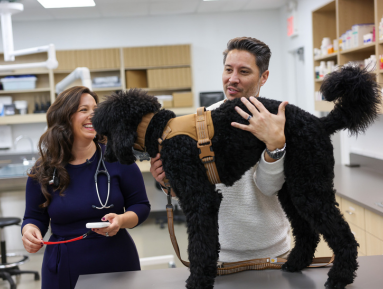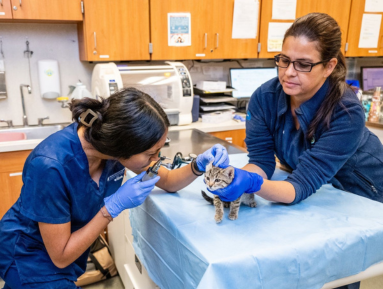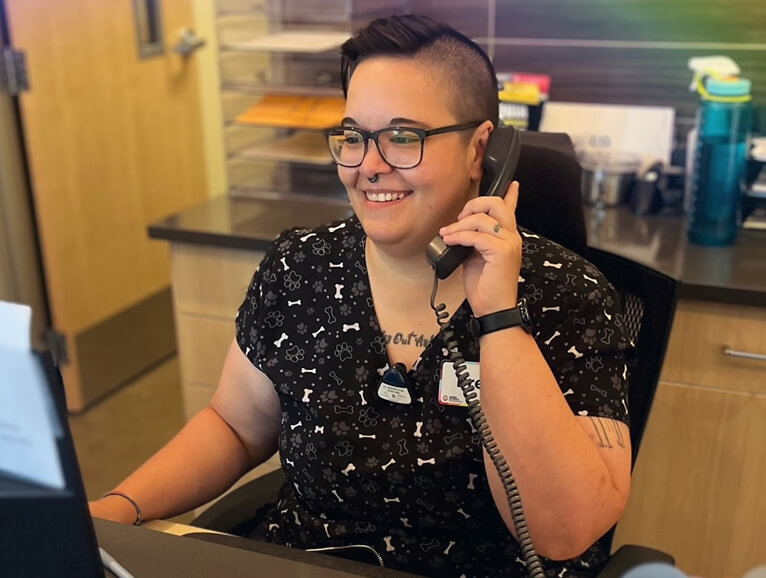
Veterinarian Journey
Veterinary Medicine
Veterinarian Journey: From Becoming Board Certified in Feline Medicine to Building a Feline-Friendly Practice
Zaya McSky, DVM, DABVP, (Feline Practice) is a Hospital Medical Leader at Vetco Total Care and recently earned her board certification in feline medicine.
Today, there are fewer than one hundred veterinarians board-certified in feline practice in the world.
We sat down with Dr. McSky to learn more about her remarkable achievement in veterinary medicine, why she finds cats so fascinating and how you can create the ultimate feline-friendly hospital experience.
Why do you find feline medicine so fascinating?
I have always had an interest in feline medicine, and I previously worked in a feline-only clinic. In general, we don’t see any many cats in veterinary medicine as we do with dogs.
For many pet parents, getting a cat to the vet can be a lot more difficult than bringing a dog in. Cats will run and hide under the bed, or fight getting into the carrier. The process can be stressful for both the cat and human.
Cats also have specialized health needs and behaviors. As a species, they are both prey and predator, so they are experts at hiding pain and disease, often for a long time. Cats are much more discrete – which can make each cat case a unique – an interesting – challenge.
Can you tell us about the process of becoming board certified?
It was a rigorous, multi-year process! To apply, you must work with your species of interest for at least five years. The application process requires 90 credit hours of continuing education in your area of species or interest, three letters of recommendation – one from a board-certified veterinarian – plus multiple essays, and skills questions.
I also had to submit two long and detailed case reports in which I managed the care from start to finish, cases that demonstrate my skills as a practitioner. The cases had to be interesting, but not so rare that there isn’t any other literature to validate the approach or outcome.
A three-person panel reviews each case, and two of the reviewers must give a passing grade on each part of the case. If any part of a case does not pass, you must wait a year to re-submit your application and cases. Finally, there is an eight-hour exam offered once a year, so if you don’t pass, you must wait a year to re-take it. Luckily, I passed my boards on the first try!
(If you’re wondering, Dr. McSky studied an hour a day every day for several months, and ramped up to six hours a day on her days off to prep for the exam.)
Can you share some of the materials you used to prepare for your exam?
I utilized multiple different strategies. I read The Cat by Dr. Susan Little, cover to cover.
I listened to every feline episode and some combined feline/canine episodes from multiple podcasts including The Cone of Shame, VetFolio, and Royal Veterinary College - Clinical Podcast.
I read most of the clinical practice American Associate of Feline Practitioner (AAFP) Journals for the past 3-5 years.
Finally, I attended as much feline continuing education as possible including the AAFP Spring conference online, the Fred Scott Feline Symposium online, and the fall AAFP conference in Memphis.
What can you tell us about the cases you included in your application?
The first case was a linear foreign body requiring multiple incisions into the intestines and a single incision in the stomach to remove what ended up being a mix of Easter basket grass, hair ties and cotton swabs. We ended up having to resect (remove) some of the intestinal tract as the foreign material had sliced through the intestines. Unfortunately, the cat didn’t wear the e-collar once she got home and chewed into her incision, so she had to return for additional surgery. She recovered without complications after her second surgery.
The second case was a cat suffering with a chronic skin disorder. The owner had taken her cat to other doctors but did not receive a definitive diagnosis. I diagnosed and treated the cat for pemphigus foliaceus, a rare autoimmune skin disease. Pemphigus foliaceus is characterized by the loss of intercellular adhesion of keratinocytes in the upper parts of the epidermis (acantholysis), resulting in the formation of superficial blisters. I was able to successfully treat the cat with a single drug protocol using immunosuppressive doses of a steroid. At the time of the case write up, the cat was doing fantastic.
What advice would you give to other doctors thinking about becoming board certified?
Go for it and stick with it! It’s a multi-year process – and it’s not easy. But if you stick with it, the certification is worth it!
How do you create a cat-friendly practice at Vetco Total Care?
As a general practice hospital, we utilize several strategies to alleviate both cat and pet parent stress.
First, we have two cat-only exam rooms. This helps decrease the smell and sound of dogs (our cat rooms share a wall). These rooms also contain cat-specific products such as Feliway and Revolution brochures.
We do all of our exams in what we call an exam box. This is a litter box with a fleece we have sprayed with Feliway. This allows cats to hunker down and essentially “hide” in the box – they feel safer – while still allowing us good access to complete a thorough exam. We sanitize each exam box between patients and replace the fleece with a fresh one each time.
We do all our treatments and diagnostics, except for radiographs, in the cat-only exam room. It takes a while for a cat to acclimate to its space and every time you move a cat, this process starts over. By keeping the cat in the exam room, we help to decrease stress on the pet. This also allows pet parents to be present for treatments and diagnostics if they choose and allows them to observe our feline-friendly handling skills. If a pet parent does not wish to be present, we will ask them to step out of the room as opposed to moving the cat. When they see how well their cat did with us, it can help to break down the barrier for the next visit.
Likewise, if our kitties are too stressed, we may stop what we are doing – unless it’s an emergency – and send home pre-appointment sedation (gabapentin). Since owners have witnessed their cat getting stressed, we have exceptional buy-in for pre-appointment sedation.
During new kitten exams, we talk with pet parents about how to acclimate a cat to their carrier. We encourage pet parents to leave the cat carrier out at all times and to routinely put beds, treats, or catnip in the carrier to make it a fun and familiar space. That way, when it’s time to take their cat to the veterinary hospital, they can simply toss a couple of treats into the carrier and the cat runs right in! This helps prevent the cats from running and hiding when they see the carrier and reduces stress for everyone involved.
Finally, we have separate cat and dog surgery days, which is far less stressful for both species. This way, when a cat is in recovery from anesthesia, it will not see dogs or hear barking.

Zaya McSky, DVM, DABVP, (Feline Practice) is a Hospital Medical Leader at Vetco Total Care and recently earned her board certification in feline medicine.
To join our team, and to work with amazing doctors like Dr. McSky, explore our career opportunities.
You also may like
-

Life @ Petco
We’re here to improve the lives of pets, pet parents and each other by fostering a welcoming, respectful and safe workplace where everyone belongs.
-

Veterinary Careers Start Here
There's more than one way to practice high-quality medicine.
-

Relief Veterinarian Opportunities
Explore the various veterinary services and career opportunities available through Vetco, including Vetco Total Care Hospitals, Vetco Vaccination Clinics, and more.
Join our Talent Community
Get the latest on career news, opportunities, and events that match your background.


Returning Applicants
If your are a returning candidate with an existing account, please click below.

Current Petco Partners
Current Partners can explore internal opportunities by logging into Workday.